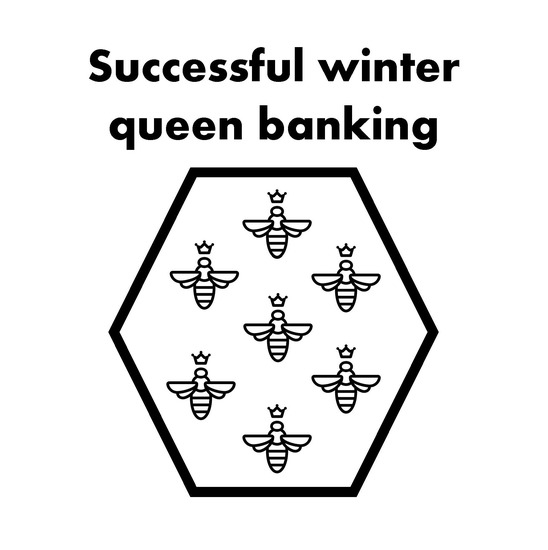Successful Indoor Mass Storage of Honeybee Queens (Apis mellifera) during Winter
Abstract
1. Introduction
2. Materials and Methods
2.1. Queen Rearing and Shipment
2.2. Queen Banking Systems and Control Queens
2.3. Mass Storage of Queens
2.4. Queen Survival, Morphometrics, and Fecundity
2.5. Queen Introduction Success and Fertility in Colonies
2.6. Statistical Analysis
3. Results
3.1. Mass Storage of Queens from September to November 2018
3.1.1. Temperature and Relative Humidity
3.1.2. Queen Survival
3.2. Mass Storage of Queens from November 2018 to April 2019
3.2.1. Temperature and Relative Humidity
3.2.2. Queen Survival
3.2.3. Queen Morphometrics and Sperm Viability
3.3. Queen Introduction Success and Fertility in Colonies
4. Discussion
5. Conclusions
Author Contributions
Funding
Data Availability Statement
Acknowledgments
Conflicts of Interest
References
- Canadian Association of Professional Apiculturists. Statement on Colony Losses in Canada; CAPA: Vancouver, BC, Canada, 2018. [Google Scholar]
- Connor, L.J. Bee Sex Essentials; Wicwas Press: Kalamazoo, MI, USA, 2008; p. 152. [Google Scholar]
- Rousseau, A.; Fournier, V.; Giovenazzo, P. Apis mellifera (Hymenoptera: Apidae) drone sperm quality in relation to age, genetic line, and time of breeding. Can. Entomol. 2015, 147, 702–711. [Google Scholar] [CrossRef]
- Woodward, D. Queen Bee: Biology, Rearing and Breeding; Northern Bee Books: Mytholmroyd, UK, 2014; p. 137. ISBN 978-1-904846-35-2. [Google Scholar]
- Bixby, M.; Hoover, S.E.; McCallum, R.; Ibrahim, A.; Ovinge, L.; Olmstead, S.; Pernal, S.F.; Zayed, A.; Foster, L.J.; Guarna, M. Honeybee queen production: Canadian costing case study and profitability analysis. J. Econ. Entomol. 2020, 113, 1618–1627. [Google Scholar] [CrossRef] [PubMed]
- Agriculture and Agri-Food Canada. Statistical Overview of the Canadian Honey and Bee Industry; Agriculture and Agri-Food Canada: Ottawa, ON, Canada, 2019. [Google Scholar]
- Canadian Food Inspection Agency. Risk Assessment on the Importation of Honeybee (Apis mellifera) Packages from the United States of America; Canadian Food Inspection Agency: Ottawa, ON, Canada, 2013. [Google Scholar]
- Pettis, J.S.; Rice, N.; Joselow, K.; Chaimanee, V. Colony failure linked to low sperm viability in honeybee (Apis mellifera) queens and an exploration of potential causative factors. PLoS ONE 2016, 11, e0147220. [Google Scholar] [CrossRef]
- Rousseau, A.; Houle, É.; Giovenazzo, P. Effect of shipping boxes, attendant bees, and temperature on honeybee queen sperm quality (Apis mellifera). Apidologie 2020, 51, 724–735. [Google Scholar] [CrossRef]
- Edwards, J.F.; Poole, H.K. Simplified method for storing honey-bee queens. Am. Bee J. 1971, 111, 270. [Google Scholar]
- Giovenazzo, P. Stockage et hivernage des reines d’abeilles (Apis mellifera). L’Abeille 1992, 13, 1–5. [Google Scholar]
- Poole, H.K.; Edwards, J.F.; Taber, S.; Mills, J.P. Storage of honeybee queens in the laboratory: An appraisal. Am. Bee J. 1973, 113, 376–378. [Google Scholar]
- Reid, M. Storage of queen honeybees. Bee World 1975, 56, 21–31. [Google Scholar] [CrossRef]
- Siuda, M.; Wilde, J.; Bratkowski, J.; Chuda-Mickiewicz, B. Wintering queen bees in modified mating nuclei. J. Apic. Sci. 2011, 55, 87–98. [Google Scholar]
- Wyborn, M.H.; Winston, M.L.; Laflamme, P.H. Mass storage of honeybee (Hymenoptera: Apidae) queens during the winter. Can. Entomol. 1993, 125, 113–128. [Google Scholar] [CrossRef]
- Gençer, H.V. Overwintering of honeybee queens en mass in reservoir colonies in a temperate climate and its effect on queen performance. J. Apic. Res. 2003, 42, 61–64. [Google Scholar] [CrossRef]
- Levinsohn, M.; Lensky, Y. Long-term storage of queen honeybees in reservoir colonies. J. Apic. Res. 1981, 20, 226–233. [Google Scholar] [CrossRef]
- Griffin, L.A.M. Advances made with queen banks in South Island. N. Z. J. Agric. 1966, 113, 41. [Google Scholar]
- Harp, E.R. Storage of queen bees. Am. Bee J. 1967, 107, 250–251. [Google Scholar]
- Prabucki, J.; Samborski, J.; Chuda-Mickiewicz, B. Experiment on storing bee queens over the winter outside the hive. J. Apic. Sci. 2003, 47, 39–46. [Google Scholar]
- Free, J.B.; Spencer-Booth, Y. Chill-coma and cold death temperatures of Apis mellifera. Entomol. Exp. Appl. 1960, 3, 222–230. [Google Scholar] [CrossRef]
- Büchler, R.; Andonov, S.; Bienefeld, K.; Costa, C.; Hatjina, F.; Kezic, N.; Kryger, P.; Spivak, M.; Uzonov, A.; Wilde, J. Standard methods for rearing and selection of Apis mellifera queens. J. Apic. Res. 2013, 52, 1–30. [Google Scholar] [CrossRef]
- Dietz, A.; Wilbanks, T.W.; Wilbanks, W.G. Investigations on long-term queen storage in a confined system. Apiacta 1983, 28, 67–70. [Google Scholar]
- Szabo, T.I. Overwintering of honeybee queens. 1. Maintenance of honeybee queens in solitary confinement. J. Apic. Res. 1975, 14, 69–74. [Google Scholar] [CrossRef]
- Stabentheiner, A.; Pressl, H.; Papst, T.; Hrassnigg, N.; Crailsheim, K. Endothermic heat production in honeybee winter clusters. J. Exp. Biol. 2003, 206, 353–358. [Google Scholar] [CrossRef]
- Sumpter, D.J.T.; Broomhead, D.S. Shape and dynamics of thermoregulating honeybee clusters. J. Theor. Biol. 2000, 204, 1–14. [Google Scholar] [CrossRef] [PubMed][Green Version]
- Southwick, E.E. Metabolic energy of intact honeybee colonies. Comp. Biochem. Physiol. Part A Physiol. 1982, 71, 277–281. [Google Scholar] [CrossRef]
- Furgula, B.; McCutcheon, D.M. Wintering productive colonies. In The Hive and the Honeybee; Graham, J.M., Ed.; Dadant and Sons: Hamilton, IL, USA, 1992; pp. 829–868. [Google Scholar]
- Currie, R.W.; Spivak, M.; Reuter, G.S. Chapter 21—Wintering management of honeybee colonies. In The Hive and the Honey Bee; Dadant and Sons: Hamilton, IL, USA, 2015; p. 1057. [Google Scholar]
- Desai, S.D.; Currie, R.W. Effects of wintering environment and parasite—Pathogen interactions on honeybee colony loss in north temperate regions. PLoS ONE 2016, 11, e0159615. [Google Scholar] [CrossRef] [PubMed]
- Doull, K.M. The effects of different humidities on the hatching of the eggs of honeybees. Apidologie 1976, 7, 61–66. [Google Scholar] [CrossRef]
- Maucourt, S.; Fortin, A.; Robert, C.; Giovenazzo, P. Genetic parameters of honeybee colonies traits in a Canadian selection program. Insects 2020, 11, 587. [Google Scholar] [CrossRef]
- Uzunov, A.; Brascamp, E.W.; Büchler, R. The basic concept of honeybee breeding programs. Bee World 2017, 94, 84–87. [Google Scholar] [CrossRef]
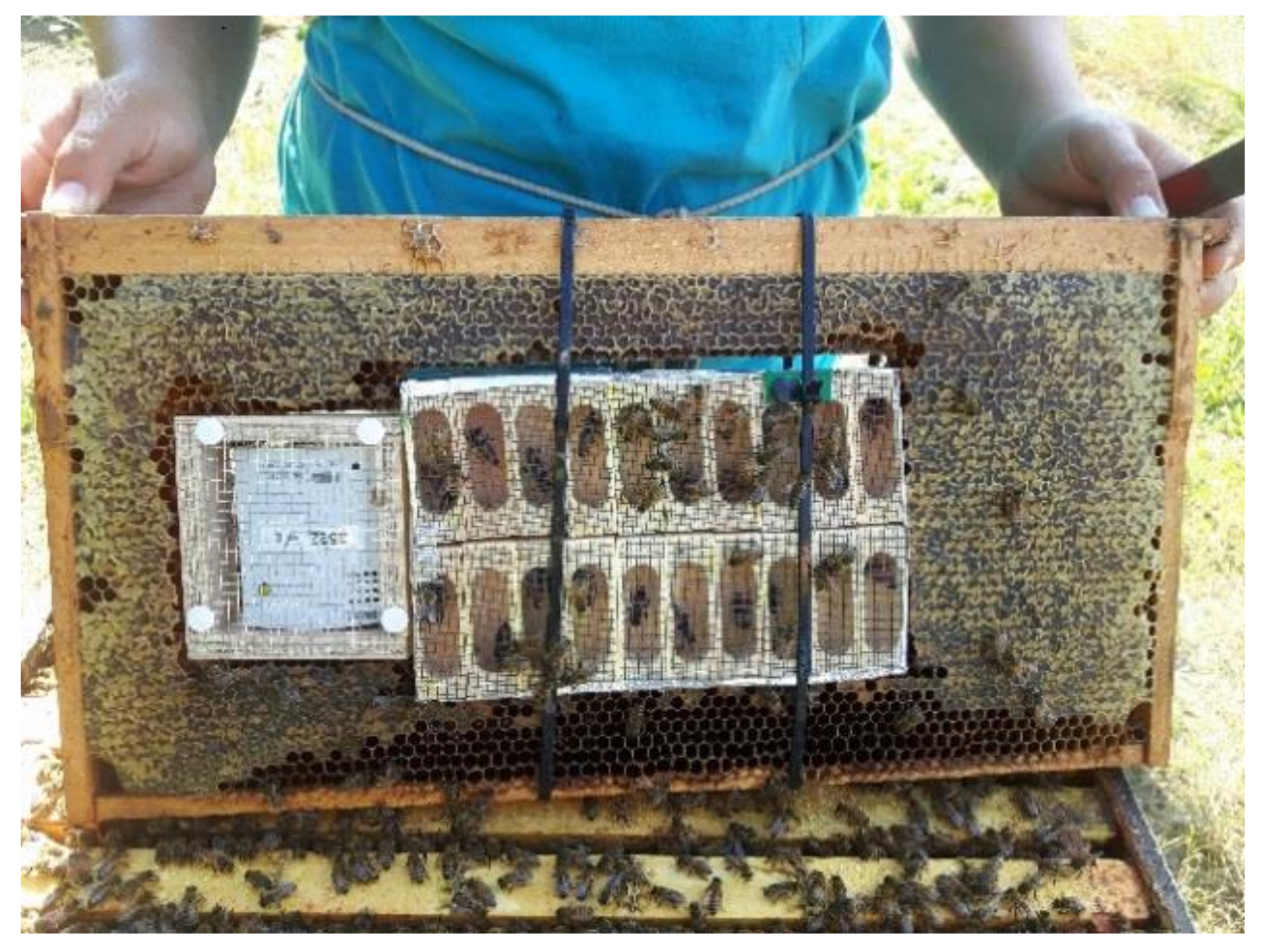
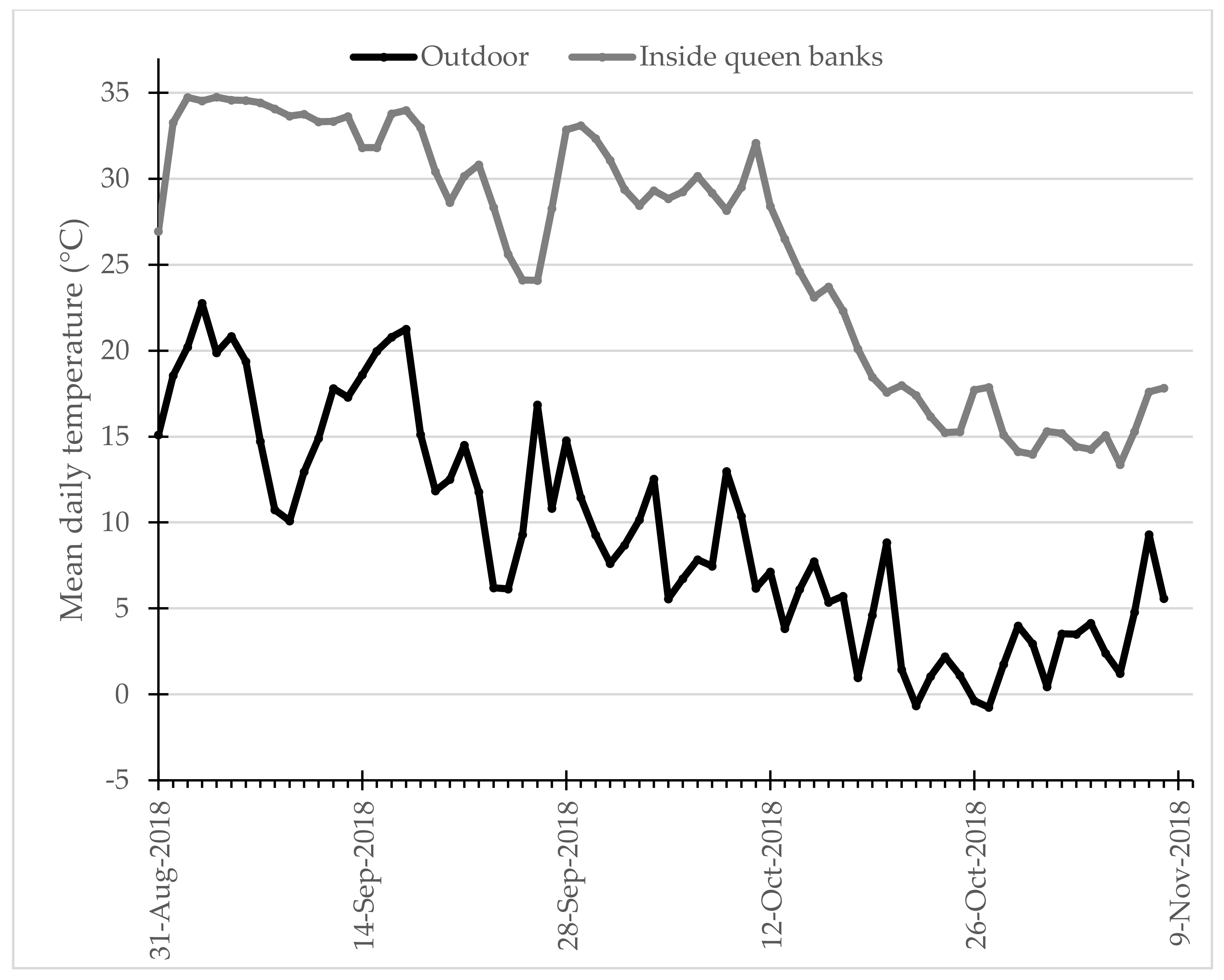
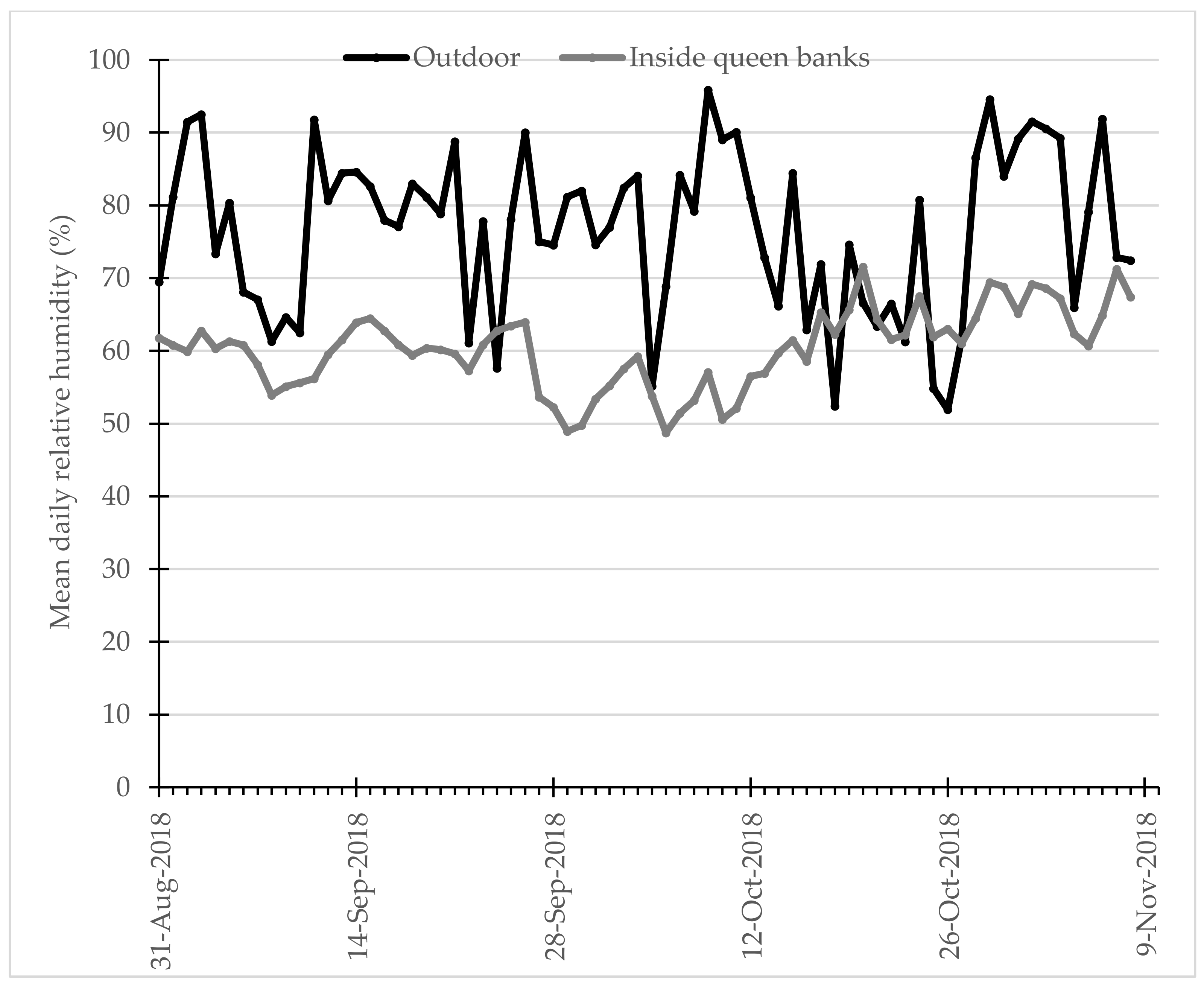
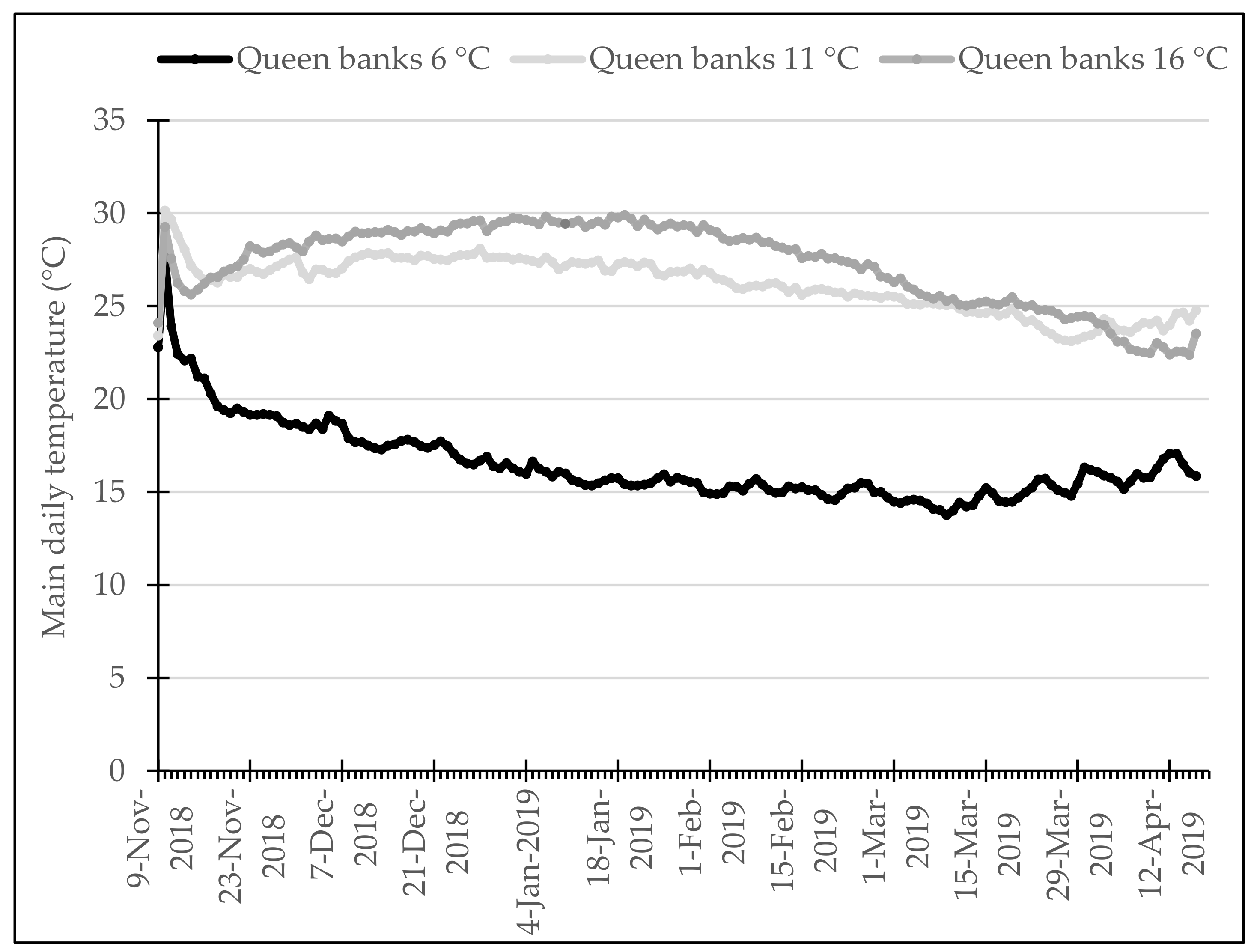
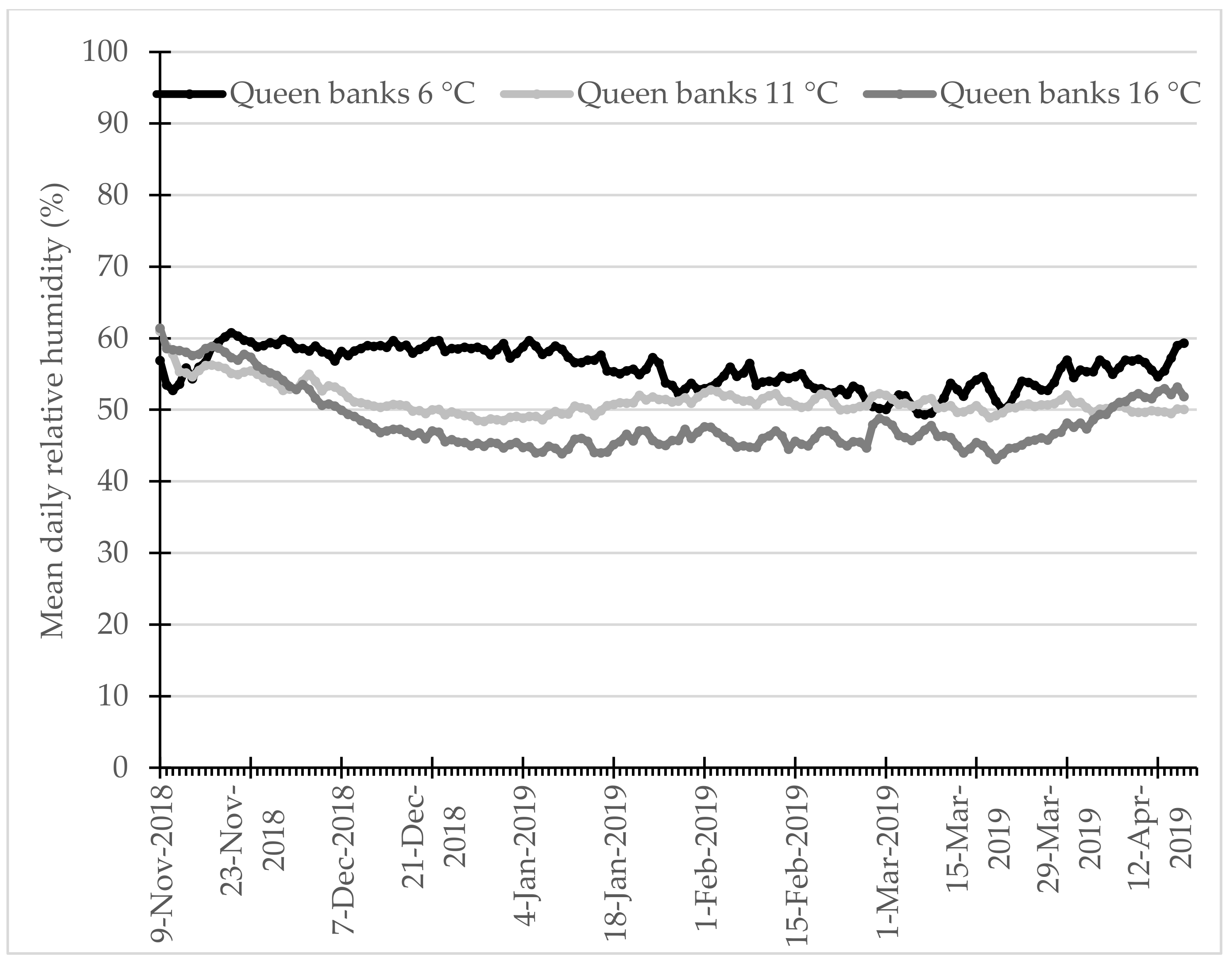
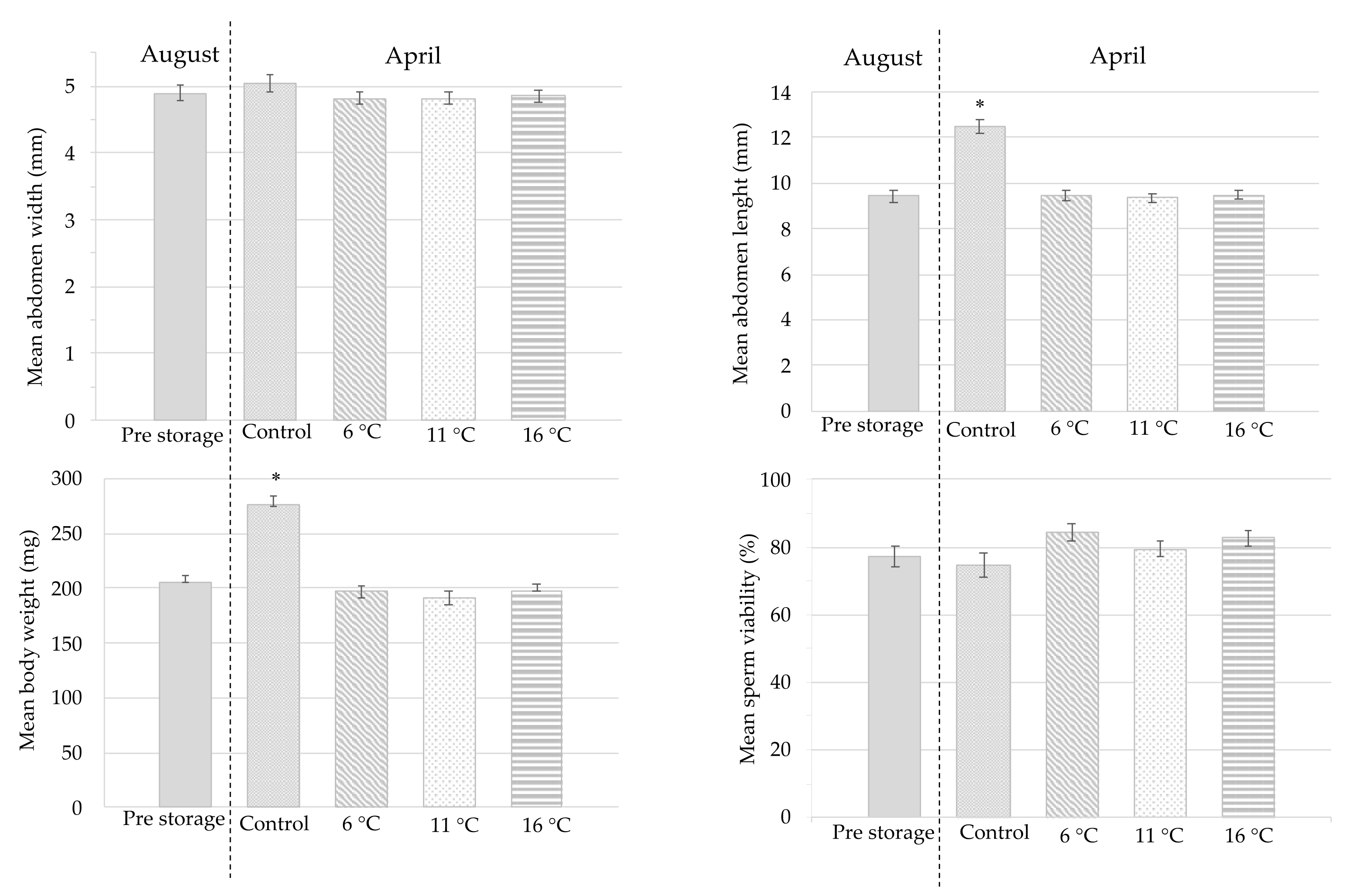
| Variable | Dates | ||
|---|---|---|---|
| 31 August 2018 (Day 0) | 9 September 2018 (Day 9) | 9 November 2018 (Day 70) | |
| Queen banks (N = 15, 40 queens/bank) | |||
| Live queens (total) | 600 | 552 | 513 |
| Live queens (mean/bank) | 40 ± 0.0 | 36.8 ± 2.1 | 34.2 ± 2.7 |
| Control colonies (N = 20, 1 queen/colony) | |||
| Live queens (total) | 20 | 20 | 20 |
| Variable | Control Colonies (N = 20, 1 Queen/Colony) | Treatment Groups (N = 5 Banks/Treatment, 40 Queens/Bank) | ||
|---|---|---|---|---|
| 6 °C | 6 °C | 11 °C | 16 °C | |
| Live queens November 2018 | 20 | 34.6 ± 1.6 | 34.4 ± 1.4 | 33.6 ± 0.5 |
| Live queens April 2019 | 14 | 19.8 ± 2.2 a | 18.6 ± 4.8 a | 29.0 ± 1.3 b |
| Variable | Treatment Groups | ||
|---|---|---|---|
| 6 °C | 11 °C | 16 °C | |
| Queen from winter banks | |||
| Queens introduced 3 May 2019 | 19 | 17 | 16 |
| Queens accepted (after 7–10 days) | 15 (79%) | 16 (94%) | 14 (88%) |
| Queens fertile August 12, 2019 | 10 (53%) | 12 (71%) | 11 (68%) |
Publisher’s Note: MDPI stays neutral with regard to jurisdictional claims in published maps and institutional affiliations. |
© 2021 by the authors. Licensee MDPI, Basel, Switzerland. This article is an open access article distributed under the terms and conditions of the Creative Commons Attribution (CC BY) license (https://creativecommons.org/licenses/by/4.0/).
Share and Cite
Rousseau, A.; Giovenazzo, P. Successful Indoor Mass Storage of Honeybee Queens (Apis mellifera) during Winter. Agriculture 2021, 11, 402. https://doi.org/10.3390/agriculture11050402
Rousseau A, Giovenazzo P. Successful Indoor Mass Storage of Honeybee Queens (Apis mellifera) during Winter. Agriculture. 2021; 11(5):402. https://doi.org/10.3390/agriculture11050402
Chicago/Turabian StyleRousseau, Andrée, and Pierre Giovenazzo. 2021. "Successful Indoor Mass Storage of Honeybee Queens (Apis mellifera) during Winter" Agriculture 11, no. 5: 402. https://doi.org/10.3390/agriculture11050402
APA StyleRousseau, A., & Giovenazzo, P. (2021). Successful Indoor Mass Storage of Honeybee Queens (Apis mellifera) during Winter. Agriculture, 11(5), 402. https://doi.org/10.3390/agriculture11050402





